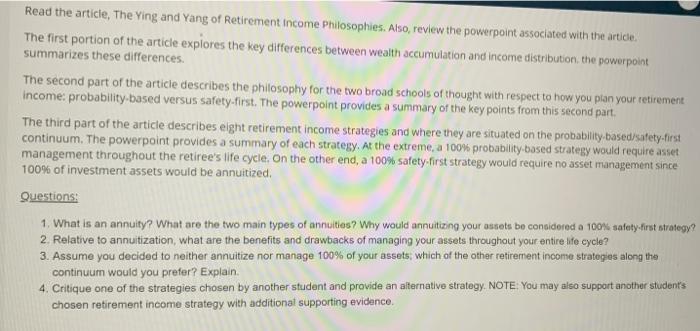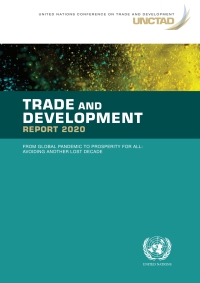Read the article, The Ying and Yang of Retirement Income Philosophies. Also, review the powerpoint associated with the article The first portion of the article explores the key differences between wealth accumulation and income distribution, the powerpoint summarizes these differences. The second part of the article describes the philosophy for the two broad schools of thought with respect to how you plan your retirement income: probability based versus safety-first. The powerpoint provides a summary of the key points from this second part. The third part of the article describes eight retirement income strategies and where they are situated on the probability-based/safety-first continuum. The powerpoint provides a summary of each strategy. At the extreme, a 100% probability based strategy would require asset management throughout the retiree's life cycle. On the other end, a 100% safety-first strategy would require no asset management since 100% of investment assets would be annuitized Questions: 1. What is an annuity? What are the two main types of annuities? Why would annuitizing your assets be considered a 100% safety-first strategy? 2. Relative to annuitization, what are the benefits and drawbacks of managing your assets throughout your entire life cycle? 3. Assume you decided to neither annuitize nor manage 100% of your assets, which of the other retirement income strategies along the continuum would you prefer? Explain 4. Critique one of the strategies chosen by another student and provide an alternative strategy. NOTE: You may also support another student's chosen retirement income strategy with additional supporting evidence Retirement income planning consists of 2 phases: wealth accumulation and income distribution. For many individuals, wealth is accumulated by making contributions to a defined contribution pension plan, individual retirement savings plans (RRSPs and TFSAS), and paying down their mortgage. Sources of retirement income include payments from the Canada Pension Plan, the Old Age Security Program a defined benefit pension plan and the conversion of the wealth accumulation accounts mentioned earlier to retirement income accounts, such as RRIFS, annuities, LRIFS, and LIFs. Read the article, The Ying and Yang of Retirement Income Philosophies. Also, review the powerpoint associated with the article The first portion of the article explores the key differences between wealth accumulation and income distribution, the powerpoint summarizes these differences. The second part of the article describes the philosophy for the two broad schools of thought with respect to how you plan your retirement income: probability based versus safety-first. The powerpoint provides a summary of the key points from this second part. The third part of the article describes eight retirement income strategies and where they are situated on the probability-based/safety-first continuum. The powerpoint provides a summary of each strategy. At the extreme, a 100% probability based strategy would require asset management throughout the retiree's life cycle. On the other end, a 100% safety-first strategy would require no asset management since 100% of investment assets would be annuitized Questions: 1. What is an annuity? What are the two main types of annuities? Why would annuitizing your assets be considered a 100% safety-first strategy? 2. Relative to annuitization, what are the benefits and drawbacks of managing your assets throughout your entire life cycle? 3. Assume you decided to neither annuitize nor manage 100% of your assets, which of the other retirement income strategies along the continuum would you prefer? Explain 4. Critique one of the strategies chosen by another student and provide an alternative strategy. NOTE: You may also support another student's chosen retirement income strategy with additional supporting evidence Retirement income planning consists of 2 phases: wealth accumulation and income distribution. For many individuals, wealth is accumulated by making contributions to a defined contribution pension plan, individual retirement savings plans (RRSPs and TFSAS), and paying down their mortgage. Sources of retirement income include payments from the Canada Pension Plan, the Old Age Security Program a defined benefit pension plan and the conversion of the wealth accumulation accounts mentioned earlier to retirement income accounts, such as RRIFS, annuities, LRIFS, and LIFs








